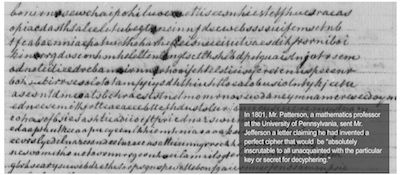"On This Date in History" Calendar
1801: Patterson's "Perfect Cipher" Letter sent to Thomas Jefferson

19 December 1801: Date of letter sent in 1801 from Robert Patterson to Thomas Jefferson with a challenge message in code attached (which Patterson called a "Perfect cipher." The code remained unsolved until 2007 when mathematician Dr. Lawren Smithline decrypted it and discovered it was The Declaration of Independence.
The information below is excerpted from a Wall Street Journal article by Rachel Emma Silverman. See the link at the end of this page to view the full WSJ article.
President Jefferson and Mr. Patterson were both officials at the American Philosophical Society -- a group that promoted scholarly research in the sciences and humanities -- and were enthusiasts of ciphers and other codes, regularly exchanging letters about them.
To Mr. Patterson's view, a perfect code had four properties: It should be adaptable to all languages; it should be simple to learn and memorize; it should be easy to write and to read; and most important of all, "it should be absolutely inscrutable to all unacquainted with the particular key or secret for decyphering."
Mr. Patterson then included in the letter an example of a message in his cipher, one that would be so difficult to decode that it would "defy the united ingenuity of the whole human race," he wrote. The code, Mr. Patterson made clear in his letter, was not a simple substitution cipher.
But Mr. Patterson had a few more tricks up his sleeve. He wrote the message text vertically, in columns from left to right, using no capital letters or spaces. The writing formed a grid, in this case of about 40 lines of some 60 letters each. Then, Mr. Patterson broke the grid into sections of up to nine lines, numbering each line in the section from one to nine. In the next step, Mr. Patterson transcribed each numbered line to form a new grid, scrambling the order of the numbered lines within each section. Every section, however, repeated the same jumbled order of lines.
The trick to solving the puzzle, as Mr. Patterson explained in his letter, meant knowing the following: the number of lines in each section, the order in which those lines were transcribed and the number of random letters added to each line.
Mr. Patterson estimated that the potential combinations to solve the puzzle was "upwards of ninety millions of millions."
Not broken until 2007 by Dr. Lawren Smithline, mathematician at Center for Communications Research at Princeton. After about a week of working on the puzzle, the numerical key to Mr. Patterson's cipher emerged -- 13, 34, 57, 65, 22, 78, 49. Using that digital key, he was able to unfurl the cipher's text:
"In Congress, July Fourth, one thousand seven hundred and seventy six. A declaration by the Representatives of the United States of America in Congress assembled. When in the course of human events..."
That, of course, is the beginning -- with a few liberties taken -- to the Declaration of Independence, written at least in part by Jefferson himself. "Patterson played this little joke on Thomas Jefferson," says Dr. Smithline. "And nobody knew until now."


